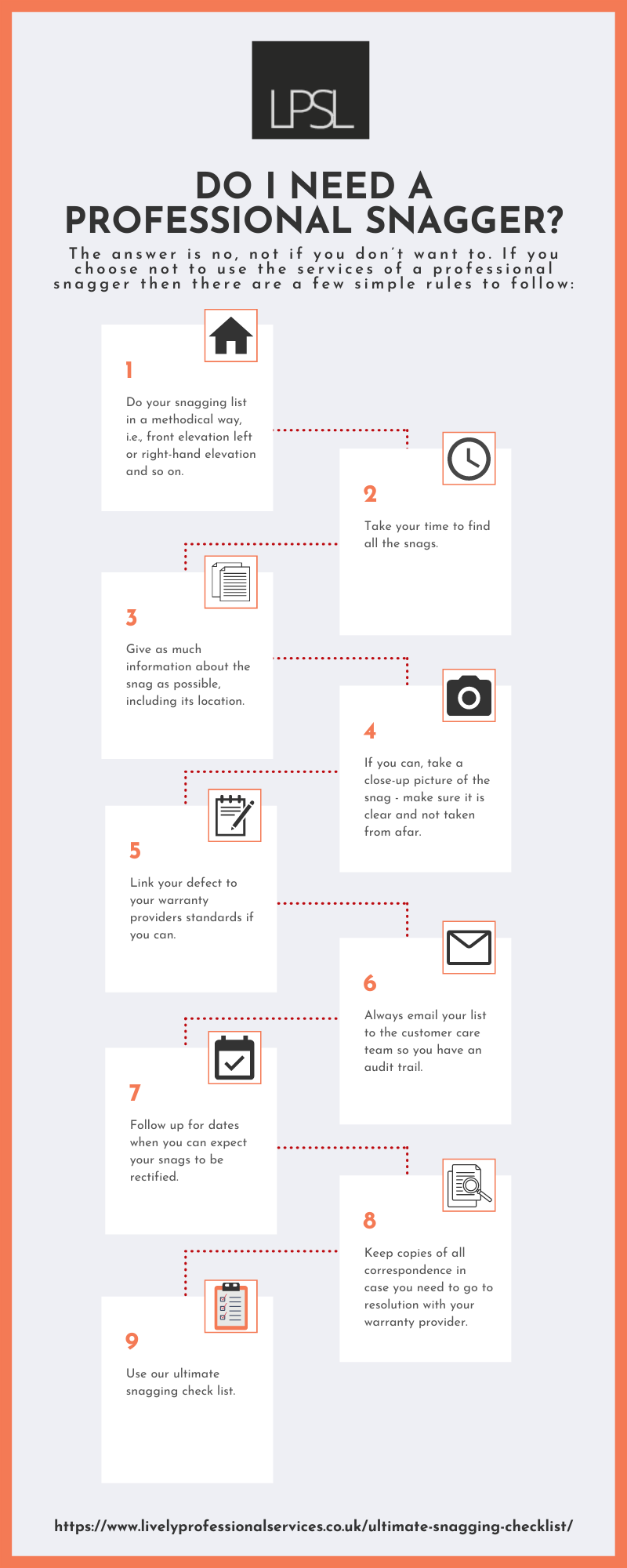As a new homeowner, you have the ability to snag or find defects yourself. Below I have compiled a simple new build snagging checklist for you to follow when inspecting your new property.
You can print and complete this snagging list template to ensure you are not forgetting about any areas. It is important that you follow this snagging list methodically, starting with the external elevations of your new home, then moving to the internal areas. This new build snagging list will help you find common defects such as damaged bricks and roof tiles, gaps or poor insulation.
Even after you have done a first assessment, we always advise using a professional snagging company to check your new build home for any defects. This is because if you do not have the experience or are not fully qualified then it is likely defects will go undetected, costing you money in the long run. But if you still opt to do it yourself, then this new build snagging list should help you along the way.
If you’re on the fence about choosing a professional snagger, we have a post that tells you the exact qualities you should be looking at right here.
The Ultimate Snagging Checklist
Exterior Snagging Checklist
Check driveways and paths aren’t damaged
Is the landscaping acceptable? E.g. the turf & no dead plants?
Fencing has been checked
Gate opens and closes properly
No gaps underneath gate that need filling
No damaged bricks at the front of the house
The window sills have been checked for damage
Windows are sealed and mastic is undamaged
The soil or chippings are 150mm lower than the DPC
Air bricks are blocked and the ground is sloping away from them
Facia boards and Soffit have been checked for damage
Roof tiles and slates have been checked for any damage
Roof tiles and slates have been checked for kicking at the valley
Ridge tiles are securley fixed
Follow the same principle with your gable elevations and move onto the rear.
Once you have completed the external of the house, inspect your garage using the same method.
For the internal of your garage use the list below.
Internal Garage Snagging Checklist
Brickwork in the pikes are fully filled to the underside of the felt with no gaps
Electrics have been checked and are working properly
The backboard has a DPC behind it
Garage door is in working condition – no damages or scratches
Walls and floor slab is clear of any access mortar droppings
Internal pillars project above the bottom of the roof truss, giving support to the pikes
Indoor Snagging Checklist
Start at your front door and work inwards to the hall and to each room that radiates from it.
Front door has been checked for any damage or scratches
Front door opens and closes properly
All paintwork has been checked, including woodwork, walls & ceiling for damage & quality
Floor slab has been checked for damage as well as any floor coverings
All doors close and latch properly
All doors and furniture checked for damage
Walls checked for damage or poor plastering
All windows are in working order with no damage or scratches to the glass
Kitchen units and worktops checked for damage and all draws align
All appliances work
Kitchen and wet room walls and floor tilings checked for damage or slipping tiles
Kitchen electrics are in working order, including grid switch
Indicated switches operate the correct appliances e.g. dishwasher, extractor hood
Patio doors open and close properly, with no scratches or damage to the glass
Follow this principle for the stairs and landing, then move into the rooms that radiate off it. Do this in a clockwise direction then you are not bouncing around from room to room and your builder will be able to follow it.
Loft/Roof Snagging Checklist
The insulation is flat and level with no gaps
The felt is intact and undamaged
Any roof vents are connected and the felt around them is not cut too big. This should also be sealed
Soil stacks checked for air admittance valves (Dergo Valve) or they are connected to roof vents
Blockwork is filled tight up to the underside of the felt on the pikes
So there it is! The ultimate easy-to-follow snagging checklist. Once you have completed this, any notes or defects should be handed to your builder.
If you’d like a hand with this, get in touch. We’re always happy to help. Or you can save the handy infographic below!





Recent Comments